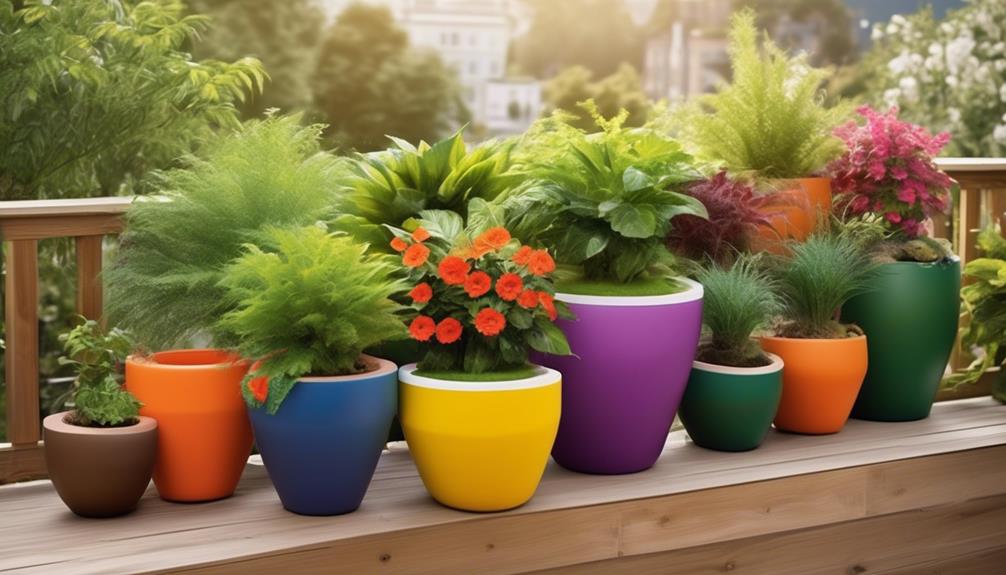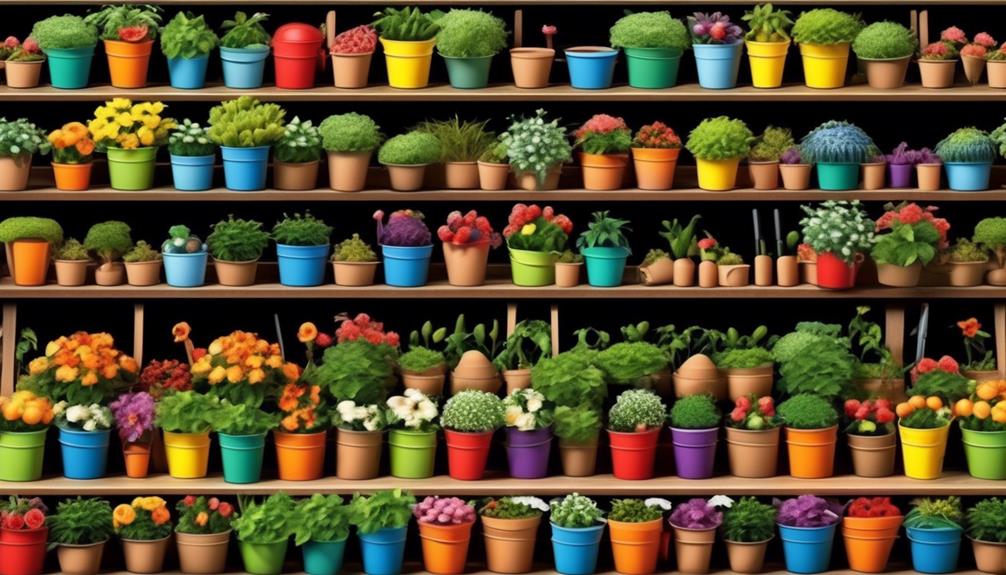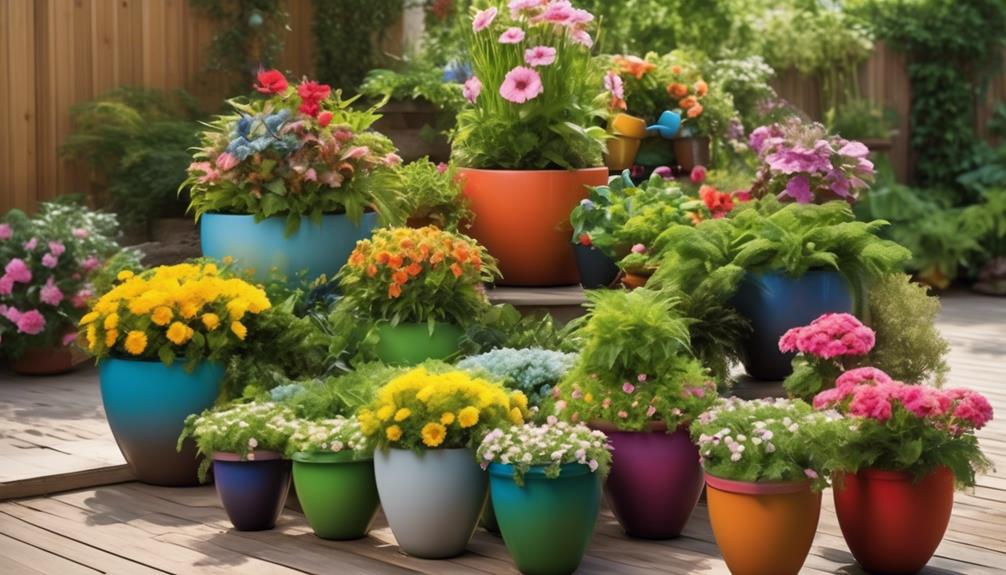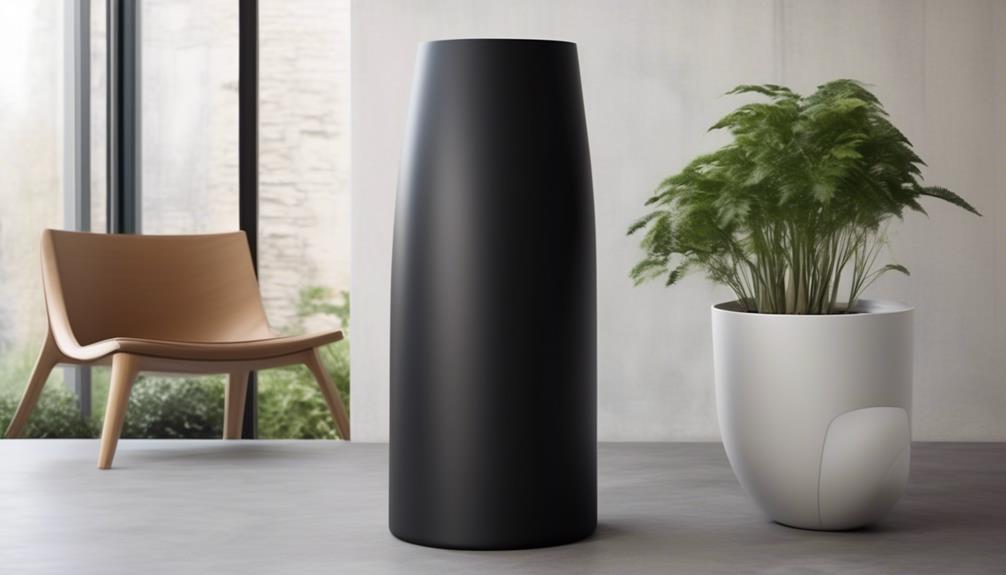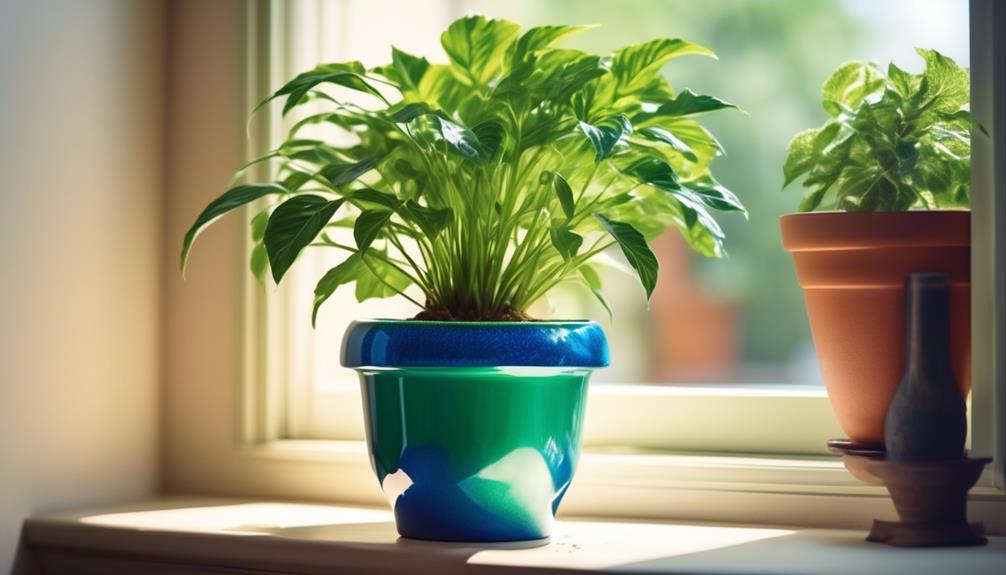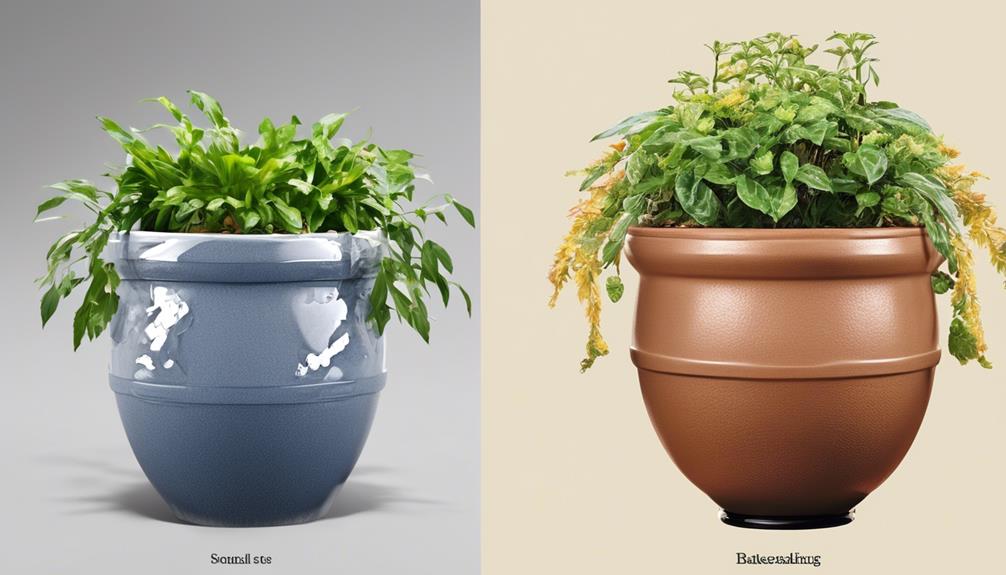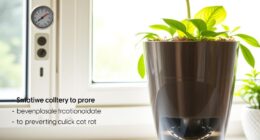We recently began using a self-watering planter on our deck to see how well it could keep our outdoor plants hydrated. The results were impressive. However, choosing the right self-watering planter and making sure it is properly maintained to promote optimal plant health requires careful attention to a few more factors.
Whether you're a seasoned gardener or just starting out, the convenience and benefits of self-watering plant pots for outdoor use are worth exploring.
Key Takeaways
- Self-watering plant pots provide a convenient and efficient way to ensure consistent moisture levels for outdoor plants.
- They reduce the need for frequent manual watering and help prevent overwatering and plant diseases.
- Self-watering pots minimize water usage by delivering moisture directly to the plant's roots.
- However, they may have a higher initial cost compared to traditional pots and require periodic maintenance for proper functioning.
Benefits of Self-Watering Plant Pots
Self-watering plant pots provide a convenient and efficient way to ensure consistent moisture levels for outdoor plants, reducing the need for frequent manual watering. The advantages of self-watering pots are numerous. They help prevent overwatering, which can lead to root rot and other plant diseases. Additionally, they can reduce water usage by delivering moisture directly to the plant's roots, minimizing evaporation and runoff. This makes them an environmentally friendly option for plant care. Furthermore, self-watering pots offer the convenience of less frequent watering, making them ideal for those who may not have the time to water their plants daily.
However, there are some disadvantages to consider. The initial cost of self-watering pots can be higher than traditional pots, and they may require periodic maintenance to ensure proper functioning. Additionally, some plants may not thrive in self-watering pots, as certain species have specific watering needs that may not align with the capabilities of these pots.
In terms of technology, future developments in self-watering pot design may focus on improving water distribution and increasing the range of plants suitable for this system. Innovations could also aim to make these pots more cost-effective and user-friendly, further enhancing their benefits for plant caregivers.
Choosing the Right Self-Watering Pot Size
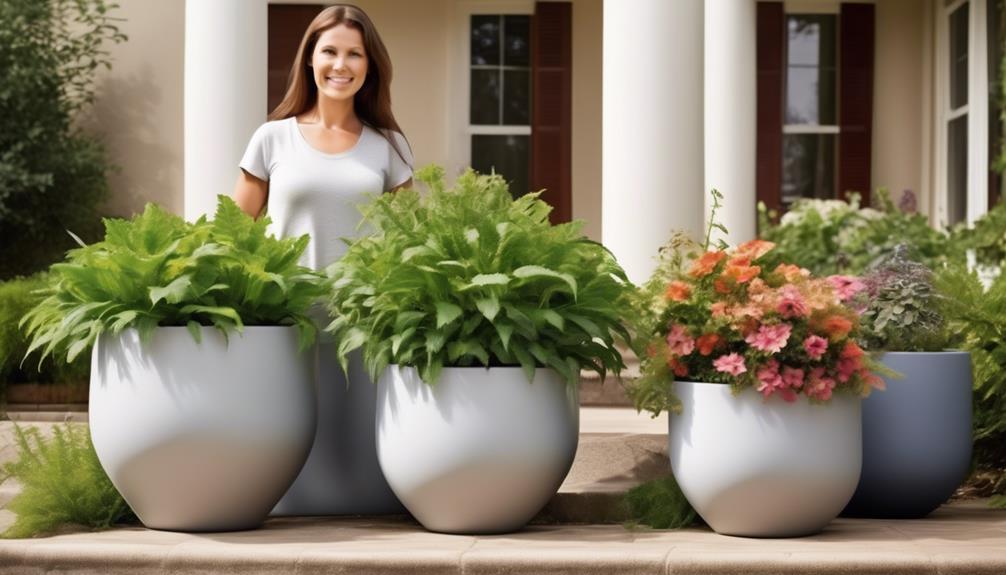
Selecting the appropriate size of a self-watering pot is crucial for providing optimal growing conditions for outdoor plants. When choosing the right self-watering pot size, it's essential to consider several factors to ensure the best environment for plant growth:
- Selecting the right material for self-watering pots: The material of the pot can affect the insulation and moisture retention properties. Plastic, ceramic, and terracotta are common options, each with its own advantages and disadvantages.
- Understanding the water reservoir capacity: The size of the water reservoir in the self-watering pot directly impacts the frequency of watering. A larger reservoir can sustain the plant for a longer duration, making it suitable for plants that require less frequent watering.
- Considering the plant's root system: Different plants have varying root systems, and it's important to choose a pot size that accommodates the specific plant's root structure to promote healthy growth.
- Assessing the space for plant growth: The pot size should be proportional to the size of the plant and the available outdoor space to ensure the plant has enough room to grow.
- Evaluating the environmental conditions: Consider the local climate and weather patterns when selecting the pot size, as this can impact the plant's water requirements and overall health.
Setting Up Your Self-Watering Plant Pot
Understanding the water reservoir capacity is essential when setting up a self-watering plant pot for optimal outdoor plant growth. When setting up your self-watering plant pot, it's crucial to consider the watering frequency and soil moisture to ensure the plants receive adequate hydration. Here's a breakdown of the key factors for setting up your self-watering plant pot:
| Water Reservoir Capacity | Ideal Soil Moisture Level | Recommended Watering Frequency |
|---|---|---|
| 1-2 gallons for small pots, 3-5 gallons for medium pots, and 6-10 gallons for large pots | Moist, but not waterlogged | Once every 1-2 weeks, depending on plant type and environmental conditions |
The water reservoir capacity determines how often you need to refill the reservoir. It's important to monitor the soil moisture level and adjust the watering frequency accordingly. This setup ensures that the plants have a consistent water supply without the risk of overwatering. By understanding these factors, you can create an optimal environment for your outdoor plants to thrive.
Maintenance Tips for Self-Watering Pots
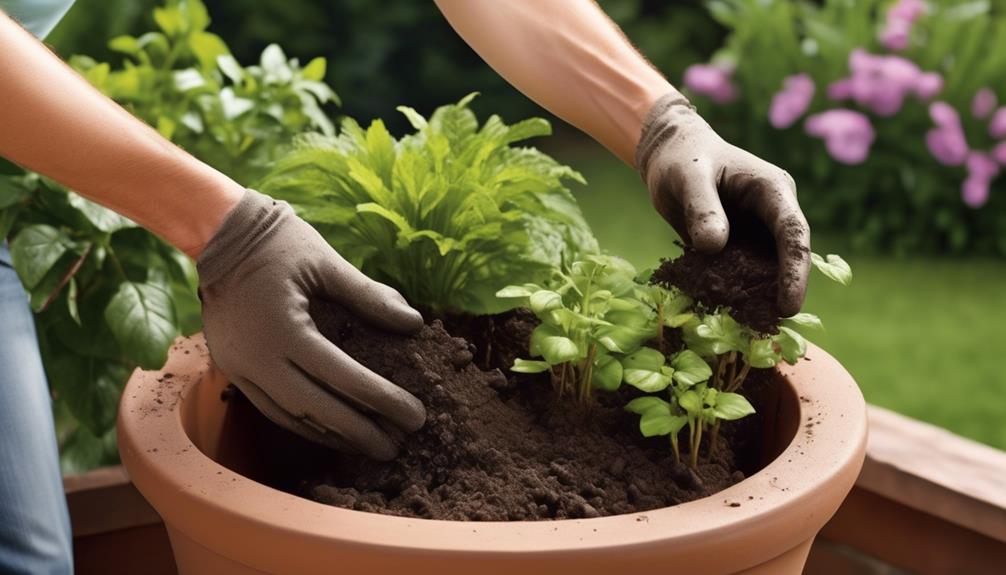
When maintaining self-watering pots, it's important to regularly check the water level in the reservoir to ensure adequate hydration for the plants. Here are some essential maintenance tips for self-watering pots:
- Inspect the Soil Moisture: Periodically check the moisture level of the soil to ensure it's within the optimal range for the specific plant. Adjust the watering system accordingly.
- Clean the Reservoir: Regularly clean the reservoir to prevent the buildup of algae, mold, or mineral deposits, which can affect the water quality and the overall health of the plants.
- Troubleshooting Common Issues: Be vigilant for any signs of malfunction, such as clogged wicks or drainage issues, and address them promptly to maintain the efficient functioning of the self-watering system.
- Seasonal Care: Adjust the water supply and plant care regimen according to seasonal changes. Plants may require more water during hot, dry weather and less during cooler months.
- Inspect for Pests: Routinely inspect the plants for any signs of pests or diseases and take appropriate measures to prevent infestations that could impact plant health.
Regular maintenance and attentive care are crucial for ensuring the optimal performance of self-watering pots and the health of the plants they support.
Best Plants for Self-Watering Containers
Choosing the most suitable plants for self-watering containers involves considering their water requirements, growth habits, and adaptability to the container environment. When it comes to plant selection for container gardening, it's essential to choose varieties that are well-suited to the self-watering system. Here are some excellent options for self-watering containers:
| Plant Name | Water Requirements | Growth Habit |
|---|---|---|
| Peace Lily | Low | Compact |
| Spider Plant | Low | Cascading |
| Herbs (Basil) | Moderate | Compact |
| Succulents | Low | Compact |
| Pothos | Low | Trailing |
Each of these plants has specific water needs and growth habits that make them well-suited for self-watering containers. Peace lilies and spider plants, for example, have low water requirements and compact growth habits, making them ideal choices. Herbs like basil and succulents also thrive in self-watering containers due to their moderate to low water needs and compact growth. Additionally, trailing plants like pothos can benefit from the consistent moisture provided by self-watering systems. When utilizing self-watering containers, it's crucial to select plants that are compatible with this watering technique to ensure optimal plant care.
Frequently Asked Questions
Can Self-Watering Plant Pots Be Used Indoors as Well as Outdoors?
Yes, self-watering plant pots can be used indoors as well as outdoors. They offer indoor benefits such as maintaining consistent moisture levels and reducing the frequency of watering.
However, there are outdoor limitations like the potential for overwatering if not monitored properly.
Maintenance tips and best practices include:
- Checking water levels regularly
- Cleaning the pots periodically
- Ensuring proper drainage.
Are There Any Specific Plants That Should Not Be Used in Self-Watering Pots?
Certain plants, like those requiring dry conditions or very specific watering schedules, may not thrive in self-watering pots.
The best plants for self-watering pots are those that prefer consistently moist soil, like ferns, peace lilies, and spider plants.
These plants thrive in the ideal conditions self-watering pots provide, ensuring they receive the right amount of water without the risk of over or under watering.
How Often Do Self-Watering Pots Need to Be Refilled With Water?
We find that self-watering pots are truly beneficial, as they provide a consistent water supply to plants.
However, the drawback is that they require regular maintenance.
The frequency of refilling depends on factors like plant type, pot size, and environmental conditions.
Generally, we suggest checking the water levels weekly and refilling as needed.
Proper maintenance ensures optimal plant health and growth, and troubleshooting any issues promptly helps to avoid potential problems.
Are There Any Special Considerations for Using Self-Watering Pots in Different Climates?
In different climates, special considerations must be made when using self-watering pots. Watering frequency may need adjustment based on climate impact and plant adaptability.
The pot material is also crucial, as it affects water retention and durability.
Understanding these factors is key to successful plant care in varying climates.
Can Self-Watering Pots Be Used for Vegetable or Herb Gardens?
Absolutely, self-watering pots are ideal for vegetable yield and herb growth. These pots provide consistent moisture, crucial for healthy root development, resulting in robust plants.
The wicking system in self-watering pots ensures that plants have access to water as needed, promoting optimal growth. This method also reduces water wastage and minimizes the risk of over or under watering, making it an efficient and sustainable option for cultivating vegetables and herbs.
Are Self Watering Plant Pots specifically designed for outdoor use?
Yes, self watering plant pots are specifically designed for outdoor use. These pots have a built-in reservoir that allows for the plants to be watered from the bottom up, providing a consistent water supply and eliminating the need for frequent watering.
Conclusion
In conclusion, self-watering plant pots are a convenient and efficient way to keep your outdoor plants hydrated without the hassle of constant watering.
With the right size pot and proper setup, these pots can help maintain the moisture levels needed for healthy plant growth.
Remember, a stitch in time saves nine, so investing in self-watering pots can save you time and effort in the long run.
Choose the right plants and enjoy the benefits of self-watering containers in your outdoor space.

